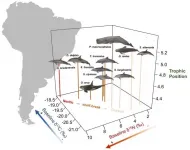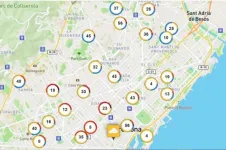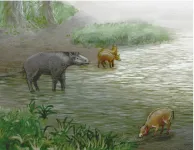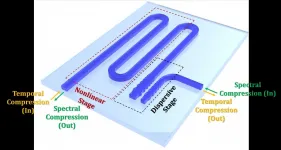An 'instruction' to the crocodylian skull
Scientists from St Petersburg University described for the first time all structures in the animal's braincase, having studied more than 70 of their 3D models
2021-07-06
(Press-News.org) The braincase of crocodylians has a distinctive structure. Unlike evolutionary relatives (birds and squamates), in crocodylians, all braincase bones are rigidly fixed together and form an akinetic structure. In the process of evolution, this made it possible for animals to develop powerful jaws and stronger bite forces, thanks to which crocodylians could gnaw through the hard shell of crayfish and turtles and hunt fish and land animals, including dinosaurs. As a result, they have managed to fill the niche of predators and survive to the present day.
At present, in comparison with other parts of the crocodylian skull, the structure of their braincase has been understudied. This is because, until recently, scientists did not have the opportunity to investigate the complicated akinetic structure so that in the end the valuable collection specimen remained intact. At the same time, there is confusion in the already known data in terms and names. This complicates the work of many researchers studying the evolution of crocodylians.
Ivan Kuzmin, a doctoral student at St Petersburg University, decided to readdress this situation together with his colleagues from St Petersburg University, the Borissiak Paleontological Institute of the Russian Academy of Sciences, the Research and Practical Clinical Centre for Diagnostics and Telemedicine of the Moscow Department of Health, and the Smithsonian Institution (USA). To achieve this, they used computed tomography and a special 3D visualization program to create and study 3D models of 75 braincases of present-day crocodylians. This made it possible, without damaging the collection samples, to literally disassemble them by the bones and study every detail. Additionally, the researchers analysed academic papers describing the structure of the braincase from the beginning of the 19th century. The earliest work studied was an article dated 1821.
As a result, the scientists compiled a summary table in which they assigned a name to each structure in the crocodylian braincase. 'Our paper is the first one in which this part of the skull is described in detail and a complete ordered list of all its details is provided. We have introduced some terms, for example, the names of bone processes in the auditory area. In some cases, because the structures were named incorrectly before us, in others, because we have discovered new elements,' notes Ivan Kuzmin, the main author of the study, Master of Science from St Petersburg University.
While studying 3D models of braincases, the researchers found previously unknown evolutionary features. According to the scientists, recent data can help to better understand the structure of the crocodylian skeleton and resolve the contradictions around the genealogical tree of reptiles. The fact is that for almost 30 years, molecular biologists and paleontologists have been unable to agree on the sequence in which crocodylian species should be located on the evolutionary tree. For example, based on gene studies, molecular biologists assume that alligators are the most basal ones, while paleontologists, studying fossil remains, come to the conclusion that the most primitive ones are gharials. 'In the future, we plan to conduct a phylogenetic analysis and, based on its results, resolve this conflict,' says Ivan Kuzmin. 'The initial assumptions show that molecular biologists might be right.'
During the research, the authors also found out through what developmental mechanisms the crocodylian braincase acquired an akinetic structure. The researchers compared the evolution of the braincase in fossil relatives of crocodylians (crocodylomorphs) with the development of the braincase in the embryos of present-day animals. They have found out that in the crocodylian braincase area, in contrast to lizards and birds, complimentary structures appear at the initial stages of ontogenesis.
'Bones in an embryo are formed in two ways: endochondral and dermal. In the former case, cartilage first appears; then it ossifies. In the latter case, bones are formed as bones initially,' explains Ivan Kuzmin. 'Most of the braincase of all animals is formed by the endochondral process. However, it has turned out that everything happens differently in crocodylians. In addition to structures that are formed through endochondral ossification, they have new elements that are formed embryonically in the form of dermal ossifications. That is, new bone blocks that are missing in other animals are attached to the cartilaginous structures, as in the LEGO construction set. With further development of the embryo, cartilages are transformed into bones, and everything merges into a single structure. The same embryonic processes likely happened during the early stages of crocodylomorph evolution.'
INFORMATION:
[Attachments] See images for this press release:
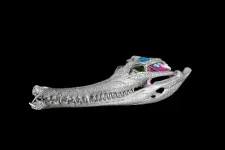
ELSE PRESS RELEASES FROM THIS DATE:
2021-07-06
Dolphin species that live together, do not necessarily compete for food
A new molecular method reveals how different species of toothed whales compete for prey and which food they choose in each other's company. Marine scientists from NIOZ recently published their work in the scientific magazine Environmental Research.
Little is still known about the food and food search behaviour of toothed whales. What we know historically, is primarily derived from the stomach content of dead specimens. However, this makes it hard to actively study them in their natural habitat: you can't do more than wait for animals to wash ashore. Consequently, ...
2021-07-06
Many standard economic models assume people make perfectly rational, individual decisions. But new research suggests economic phenomena like inequality and business cycles are better explained by models which recognize that people's decisions are affected by the decisions and the behaviors of people around them.
To show this, researchers built a model in which households are embedded in a social network that powerfully affects their savings decisions. This fairly simple model resulted in cyclical fluctuations resembling business cycles, as well as in emergent inequality - for instance, many poor households with low saving rates and a few rich households with high saving ...
2021-07-06
* Clinical trial at University of Warwick compares the familiar cast, traditionally signed in sympathy, to modern removable brace for immobilising broken ankles
* Cast was not more effective, with patients reporting similar levels of pain and functionality, suggesting that choice should be down to patient preference and cost effectiveness
* Some data suggested a patient preference for the removable brace - sometimes referred to as the 'Beckham boot' after David Beckham
Using a cast is not more effective than a brace for treating broken ankles, according to University ...
2021-07-06
An elegant new algorithm developed by Danish researchers can significantly reduce the resource consumption of the world's computer servers. Computer servers are as taxing on the climate as global air traffic combined, thereby making the green transition in IT an urgent matter. The researchers, from the University of Copenhagen, expect major IT companies to deploy the algorithm immediately.
One of the flipsides of our runaway internet usage is its impact on climate due to the massive amount of electricity consumed by computer servers. Current CO2 emissions ...
2021-07-06
Medical researchers at Ludwig-Maximilians-Universitaet (LMU) in Munich have uncovered how signal proteins of the immune system regulate the development of atherosclerosis.
Atherosclerosis is one of the most common causes of death in Germany. The condition is characterized by the build-up of cholesterol and other fatty metabolites in the arterial wall directly below the endothelial cell layer, which is in direct contact with the bloodstream. This process results in constriction of the artery, which obstructs blood flow and can trigger heart attacks and strokes. Atherosclerosis is generally treated with drugs that reduce the concentration of lipids in the circulation, often using compounds called statins. However, statins effectively reduce the risk of cardiovascular ...
2021-07-06
Dysmenorrhea, that is, frequent severe and painful cramps during menstruation from abnormal contractions of the uterus, is the most common of all gynecological disorders. It affects between 16-91% of girls and women of reproductive age, of whom 2%-29% have symptoms severe enough to restrict their daily activity. Now, for the first time, researchers from China Medical University Hospital in Taiwan have shown that long-term exposure to air pollutants such as nitrogen and carbon oxides and fine particulate matter greatly raises the risk of developing dysmenorrhea. Based on long-term data on air quality and public health from national databases, they show that the risk to develop dysmenorrhea ...
2021-07-06
A study led by University of Barcelona researchers and carried out together with more than 1,650 students and their family members from 18 educational centres in Barcelona shows that citizen science is a valid approach able for doing high quality science, and in this case, able to provide nitrogen dioxide values with an unprecedented resolution and to assess the impact of the pollution in the health of their inhabitants.
The journal Science of the Total Environment has published the results of a study carried out by the research group OpenSystems of the University of Barcelona, the Barcelona Institute for Global Health (ISGlobal), promoted by La Caixa Foundation ...
2021-07-06
Participants at the 6th Joint Science Conference of the Western Balkans Process have developed a "10 Point Plan" to control the coronavirus pandemic in the Western Balkans. Participants at the virtual two-day meeting also discussed priorities for the time after the pandemic in the Western Balkans and South East Europe. These include a decent healthcare system, climate neutrality, reduction of air and water pollution, and the digitalization of education, public administration, industry and healthcare. The conference was jointly organized by the German National Academy of Sciences Leopoldina and the Polish Academy of Sciences as part of the Western Balkans ...
2021-07-06
Although hypomorph mammals (or equids) are currently represented by only one genus ('Equus') and just a handful of species of horses, donkeys and zebras, they were more diverse during the Eocene epoch (between 56 and 33.9 million years ago). One of the most widespread groups in Europe, which was an archipelago at that time, were the palaeotheriidae, named after the genus 'Palaeotherium', described in 1804 from fossils originating in the quarries of Montmartre (Paris) by the famous French naturalist George Cuvier.
The international Journal of Vertebrate Paleontology has recently published a paper on a study led by Leire Perales-Gogenola describing two new species of palaeotheriidae mammals that inhabited the subtropical landscape of Zambrana (Álava) ...
2021-07-06
Big hydropower plants are an important source of clean and cheap electricity for many countries in Southeast Asia. However, dams harm the environment and have dire consequences on local communities. Building more dams would therefore pose major trade-offs between electricity supply and environmental protection.
A team of scientists based in Singapore showed that these two challenges can be decoupled. Their study, titled "Solar energy and regional coordination as a feasible alternative to large hydropower in Southeast Asia", recently published in Nature Communications, showed that there are more sustainable pathways to a clean energy future (refer to figure below).
Building on high resolution mathematical models of the Thai, Laotian, and Cambodian ...
LAST 30 PRESS RELEASES:
[Press-News.org] An 'instruction' to the crocodylian skull
Scientists from St Petersburg University described for the first time all structures in the animal's braincase, having studied more than 70 of their 3D models

